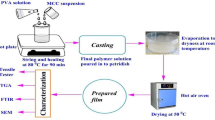Abstract
Plasma treatments can be utilized to upgrade the value of lignocellulosic materials for applications such as biobased composites. Poor adhesion in biobased composites is caused by incompatibility between polar cellulosics and non-polar thermoplastics. Plasma modification of both cellulose and polypropylene was evaluated by a T-peel test for improved compatibility and adhesion between these materials. Oxygen and argon plasmas were used to modify the surface of polypropylene films, while a cyclohexane plasma was used to modify the cellulose surface through deposition of a hydrophobic polymer layer. For plasma treatment of polypropylene, changes in power input had a greater effect on adhesion than changes in pressure. Surface oxidation and increased acid/base characteristics were found on both argon- and oxygen-plasma-treated polypropylene based on ESCA and wetting measurements. With the non-reactive argon plasma the persistence of reactive species, such as free radicals, was very important for enhanced adhesion. The amount of polar carbonyl groups introduced onto the surface was also an important factor for adhesion improvement. Modification of the cellulose (filter paper) surface to a hydrophobic character with a cyclohexane plasma did not improve adhesion to polypropylene.
Similar content being viewed by others
References
Back, E. L. and Danielsson, J. W. (1987)Nordic Pulp Paper, Res. J., Special Issue 2, 53–60.
Proceedings of the Second Annual International Conference on Plasma Chemistry, edited by H. V. Boenig (Lancaster, PA, USA, Technomic Pub., 1986).
Briggs, D. and Kendall, C. R. (1979)Polymer 20, 1053–1054.
Brown, P. F. and Swanson, J. W. (1971)Tappi 54, 2012–2018.
Carley, J. F. and Kitze, P. T. (1980)Polymer Eng. Sci. 20, 330–338.
Chung, F. H. (1991)J. Appl. Polymer Sci. 42 1319–1331.
Denes, F., Sarmadi, A. M., Hop, E. C. A. and Young, R. A. (1993)ibid., Polymer Symposia, in press.
Goring, D. A. I. (1967)Pulp and Paper Magazine of Canada 68, T-372–T-376.
Hall, J. R., Westerdahl, C. A. L., Devine, A. T. and Bodnar, M. J. (1969)J. Appl. Polymer Sci. 13, 2085–2096.
Hansen, M. H., Finlayson, M. F., Castille, M. J. and Goins, D. (1993)Tappi 76(2), 171–177.
Holmes, S. and Schwartz, D. (1990)Composites Sci. Tech. 38, 1–21.
Huttinger, K. J. (1990). InCarbon Fibers Filaments and Composites (J. L. Figueiredoet al., eds). New York: Kluwer Academic Publishers, pp. 245–258.
Jung, H. Z., Ward, T. L. and Benerito, R. R. (1977)Textile Res. J. 47, 217–223.
Kaelble, D. H., Dynes, P. J. and Cirlin, E. H. (1974)J. Adhesion 6, 23–48.
McKelvey, J. M. (1962)Polymer Processing. New York: John Wiley & Sons.
Owens, D. K. (1975)J. Appl. Polymer Sci. 19, 26–32.
Schonhorn, H. and Hansen, R. H. (1967)ibid.,11, 1461–1474.
Westerlind, B. S. and Berg, J. C. (1988)ibid.,36, 523–534.
Yasuda, H. and Lamaze, C. E. (1973)ibid.,17, 1533–1544.
Young, R. A. (1978)Wood and Fiber 10(2), 112–119.
Idem. (1986). InCellulose: Structure, Modification and Hydrolysis (R. A. Young and R. M. Rowell, eds). New York: John Wiley & Sons, pp. 91–128.
Idem. (1992). InEmerging Technologies for Materials and Chemicals from Biomass (R. Rowell, T. Schultz and R. Narayan, eds). Washington, D. C.: Amer. Chem. Soc., pp. 115–135.
Author information
Authors and Affiliations
Rights and permissions
About this article
Cite this article
Tu, X., Young, R.A. & Denes, F. Improvement of bonding between cellulose and polypropylene by plasma treatment. Cellulose 1, 87–106 (1994). https://doi.org/10.1007/BF00818801
Issue Date:
DOI: https://doi.org/10.1007/BF00818801




